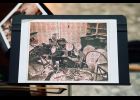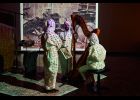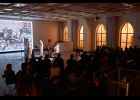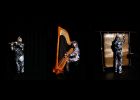“We shall be your favorite disappearing act!” / Clare Strand, Playing a Photograph
This essay discusses the intellectual foundation of the research group Thinking Tools at the Royal Academy of Antwerp. Established within the photography department at the Academy, the research group quickly decided to mainly support research into experimental photographic practices that radically question existing presuppositions. It starts from André Bazin's contention photography is the only way we can enjoy the absence of the human hand in the production of an image and goes on to explore how this theme of absence has become a guiding principle for the research group. The writings of Vilém Flusser on photography introduced us to the concept of the apparatus and to the photographer as an operator. These allow us to critically rethink the idea of photography as a simple instrument of image making. For a better understanding of the sovereignty of the camera we turned another thinker inspired by Flusser, the French photohistorian Michel Frizot. His definition of photography as the conjunction of an optical and a chemical system helped us to grasp in more concrete terms how photography radically differs from other existing art forms. Combining the theoretical positions of Flusser and Frizot gave us a robust framework for the 2021 publication Off Camera which set out to demonstrate how the concept of ‘the photographic’ expanded into the larger realm of the visual arts. The essay concludes with a discussion of two artists whose work could illuminate how this concept of ‘the photographic’ is at play in contemporary art.
Clare Strand’s “Playing a Photograph” is a telematic dialogue between a photograph and musical performers from the Royal Conservatoire (https://vimeo.com/773269239/c934f6a17a).
Flusser’s Sonic Modernity
This chapter addresses Flusser’s often neglected writings on music and sound as they relate to his understanding of modernity. Taking two lectures ‘On Music’ and ‘On Modern Music’ given in Sao Paolo in 1965 as its departure point, Flusser’s conceptualization of a sonic modernity is examined within his ‘communicological’ theory. Contrary to a McLuhanesque media theory of the auditive, I argue Flusser’s theorization is distinct due to his characteristic ‘groundlessness’ and seeks to destabilize, rather than restabilize, a liberal Western humanist modernism.
Flusser, music and me
O sete teso / O medo do Demo
The Dimension of Sound in Flusser
The dimension of sound has long been considered completely missing from Flusser's thought, thus most Flusser research has not dealt with the auditive in his work so far. This article has a two-fold approach to counter this common perception; firstly, by looking at three (German) texts in which Flusser deals with music and sound directly – “Chamber Music”, “The Gesture of Listening To Music” and “Hörigkeit/Hoerapparate”, and secondly by looking at Flusser's key text “Crisis of Linearity” which largely ignores sound. The former tackles these lesser known texts to examine how Flusser actively (though rarely) applied music and sound in his work, whilst the latter uses methods of sound studies to critique the absence of sound in his important media-philosophical thesis. Flusser's writings on music and sound are both striking for the contemporaneity yet problematic for their demoded appearance of concepts such as “pure music”. Insights from contemporary sound studies question the dominance of the visual in Flusser's work and the epistemological consequences this might have.
“To make music with visionary power”. On the Relationship of Music and Mathematics in Vilém Flusser’s Work
This essay deals with the relationship of mathematics and music in Vilém Flusser’s work, an aspect that has not received the attention it deserves. Related issues are the complex dialectics of sound, number, image and word as well as the relationship of hearing and seeing. The essay focuses on two texts written 22 years apart but closely connected to each other: The History of the Devil (1963) and Into the Universe of Technical Images (1985). This makes it possible to illustrate the inner coherence of the whole oeuvre and the persistence with which Flusser kept returning to the same central issues of his thinking and writing. In the context of the issue discussed here, this leads to an all-encompassing synthesis of several diverging aspects. In the new computerized technical images mathematics and music, the West and the East, art and science merge, the senses and the codes come together, the eye, the ear and the fingertips, the visual, the acoustic and the tactile converge and fuse creating a new unheard of and unseen multilingual, multi-mediatic and multi-discursive unity.
Das Strahlen in der Black Box. – Sprechen und Hören in der Medienphilosophie Vilém Flussers
This essay explores the rather rare studies on the subjects of speaking and hearing in the works of Vilém Flusser. It begins by identifying the historical and systematical modes of speaking and hearing in Flusser’s media philosophy. The phenomenology of the body (Leib) plays a central role in the discussion of these particular modes of communication. Significant for Flusser’s interpretation of these modes is the relation they have to a notion of political space. In this regard the essay asks: what is the impact of “the end of politics” on speaking and hearing?






